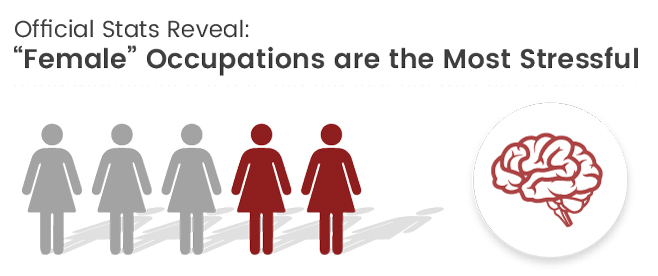BLOG
National Stress Awareness Day: “Female” Occupations are the Most Stressful
Nov 1 2017
Darren Best

The Highest Rates of Work Related Stress in Public and Health Sectors
Over the years 2014/15-2016/17, public service industries such as public administration and defence; health and social care; and education were found to be the most stressful industry categories, with the “traditional female” occupations all having significantly higher work-related stress rates in jobs such as welfare, nursing and midwifery, and teaching professions. Human health and social work activities had the highest prevalence rate for work related stress: 2,050 cases per 100,000 workers. The education sector and public administration and defence; compulsory social security had work-related stress levels of 1,860 cases and 1,840 cases per 100,000 workers respectively. The reported work-related stress in all three industries was statistically significantly higher from the rate across all industries which was 1,230 cases per 100,000 workers over the years 2014/15-2016/17. Breakdown by occupations reveals that the highest rates of stress are reported by those working in professional services and in particular occupations with high proportions of female employees. At a staggering 4,420 cases per 100,000 workers, welfare professionals had the highest rates of work related stress, followed by nursing and midwifery professionals at 3,090 cases and teaching professionals at 2,460 cases per 100,000 workers.
Female Workers Over 60% More Likely to Suffer Stress
Compared to men, women were found to be more likely to suffer work related stress. According to the latest HSE’s report on work related stress, the prevalence of work related stress among male workers was 1,170 cases per 100,000 workers. Among their female colleagues, the prevalence rate was 1,880 cases per 100,000 workers. That’s over 60% higher than in men and 16.7% higher than for all persons combined (1,610 per 100,000 workers). The new report by HSE also reveals a difference in stress rates among women within different age categories. All age categories 25-34 years, 35-44 years and 45-54 years had higher work-related stress rates than both men and all persons combined. But while the stress prevalence among those aged 25-34 (1,930 per 100,000 workers) was only slightly higher than the overall rate for women, age groups 35-44 years and 45-54 years were both significantly higher at 2,120 and 2,430 persons per 100,000 respectively. The rates of work-related stress were lowest in age categories 16-24 and 55+ years at 1,110 and 1,420 cases per 100,000 workers respectively. Photo credit: VCoscaron/Shutterstock
Photo credit: VCoscaron/Shutterstock
Reasons for Higher Work-Related Stress Rates in Female Workers
Workload, especially tight deadlines, and too much work, pressure or responsibility are according to the HSE report the most common cause for work related stress. Other factors that were highlighted as major contributors to stress at work include a lack of managerial support, changes at work, lack of control, violence/bullying and job uncertainty as well as interpersonal relationships at work. None of these, however, explains why women have higher rates of work related stress than men. The HSE statisticians noted that the difference between men and women for reported stress can also be attributed to factors such as differences between men and women in attitudes and beliefs about stress. However, it was noted that higher stress rates in women are also due to the fact that women are more likely to be employed in high-stress occupations, such as nursing and teaching. It’s thus safe to conclude that the “traditional female” occupations are especially stressful. Photo credit: Creativa Images/Shutterstock
Photo credit: Creativa Images/Shutterstock